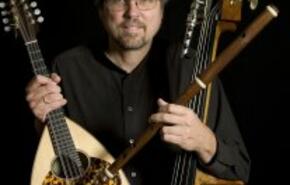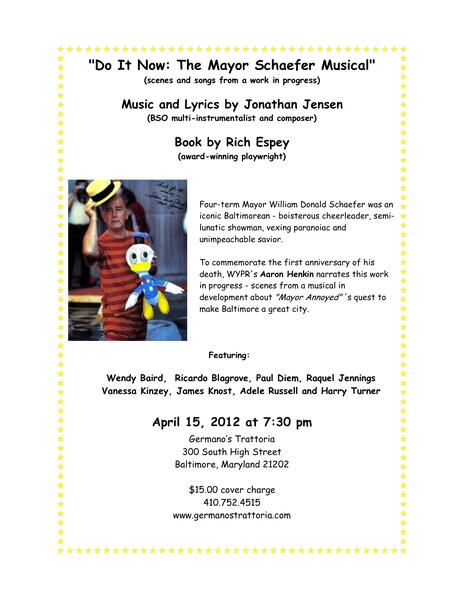About Jonathan

A Maryland native, Jonathan Jensen credits several influences with shaping his path as a composer and performer: the songs his mother played and sang at the piano, his brother's collection of 78 rpm records, the concerts and Broadway shows he attended as a child, hootenannies out on the patio, and years of music lessons. All of this eventually led to a career as a musical chameleon: Baltimore Symphony bassist, pianist for folk and ballroom dancing, mandola player with the Baltimore Mandolin… more
Jump to a project:
Candles in the Dark
The tune "Candles in the Dark" was composed spontaneously at the piano by candlelight when Hurricane Hugo knocked out our electricity in 1999. Since that time it has made its way around the country, has been recorded on at least five CDs and has had a dance choreographed to it. Here are three of my favorite renditions by other artists.
-
Candles in the Dark - AshbrookThis live performance from 2006 captures the meditative atmosphere of flickering candles that inspired the tune. From Karen Ashbrook's CD "Spring Will Come". Karen Ashbrook, hammered dulcimer Paul Oorts, harp guitar
-
Candles in the Dark - SchwabIn the latest recording of "Candles", pianist Jacqueline Schwab uses my tune as a springboard for her imagination, combining both the rhythmic drive and atmosphere of the previous interpretations while creating something entirely her own. Jacqueline is best known for her work with filmmaker Ken Burns, most notably on the soundtrack of his acclaimed documentary "The Civil War".
-
Candles in the Dark - MitchellFor the opening track of his CD "Chameleon", Alexander Mitchell transformed my slow, atmospheric waltz into something more energetic and improvisatory, with a dash of Latin flavor. Alexander Mitchell, violin and percussion, Paul Oorts, mandolin, Dave Wiesler, piano, Ralph Gordon, bass
Kid Stuff
I have been involved as a composer, arranger and performer in educational concerts for school children since 1977. These two clips give an example of some of my recent activities in this field: a composition for oboe trio and student recorder players, and an excerpt from a presentation on the families of musical instruments that I do with BSO percussionist Chris Williams.
-
Irish FantasyCommissioned by the BSO On The Go outreach program, this piece combines a traditional Irish slow air, jig and slip jig with a simple pentatonic melody designed for easy execution by 4th grade recorder players. It is performed here by Trio La Milpa (Katherine Needleman, Sandy Lisicky, Michael Lisicky) and students from Grace Episcopal School in Silver Spring, MD.
Music for Mandolins
For over a decade I've been involved in the classical mandolin world as a performer, arranger and composer. Here are three original works for mandolin ensemble, recorded live in performance.
-
Waltz For DianeThis memorial to a departed friend was composed spontaneously at the piano and later arranged for the Baltimore Mandolin Quartet. Here the BMQ performs it at the 2011 Classical Mandolin Society of America convention in Baltimore. David Evans and Laura Norris, mandolins, Jonathan Jensen, mandola, Tony Norris, guitar.
-
Ricordi di Autunno (Memories of Autumn)This mazurka in traditional Italian style was written for mandolin virtuoso Carlo Aonzo. Here he performs it in concert at An Die Musik, accompanied by myself on mandola and Tony Norris on guitar.
-
Swimming Down The StarsA friend described for me a memorable midnight swim in a country pond where she felt the stars were right overhead and that she was swimming down the length of the Milky Way. She asked me to write her a tune with the title "Swimming Down The Stars", and this waltz was the result. Here it is performed at a mandolin convention by an orchestra of 150 amateur mandolinists and guitarists.
Three to Tango
A Piazzolla piece and an original which I arranged and performed (on double bass) with violinists Jonathan Carney and Igor Yuzefovich on the Chamber Music By Candlelight concert series at Second Presbyterian Church in Baltimore; Nov 21, 2010.
-
The Last Tango in LeipzigA tongue-in-cheek tango treatment of five themes by J. S. Bach: Concerto for two violins, a fugue from the Well-Tempered Clavier, Partita for solo violin in E, Brandenburg Concertos #3 and #5. Jonathan Jensen, composer and double bass, Jonathan Carney and Igor Yuzefovich, violins. Originally composed and performed as an encore piece for a BSO concert.
-
LibertangoOne of Astor Piazzolla's best-known tangos. Jonathan Jensen, arranger and double bass, Jonathan Carney and Igor Yuzefovich, violins.
Orchestral Arrangements
I taught myself orchestration soon after joining the Baltimore Symphony Orchestra in 1983, and before long was called upon to provide special arrangements and short compositions for the orchestra. Here are two of these pieces in contrasting moods.
-
A Night At The PopsOne of several short "curtain raisers" commissioned by the BSO for their 75th anniversary in 1991, this is what I call a freeze-dried pops concert, which quotes over 30 show tunes, old standards, movie themes and light classics in 6 minutes.
-
Deep RiverIn November 2001 the Baltimore Symphony Orchestra embarked on a European tour with our music director, Yuri Temirkanov. As the 9/11 attacks were still fresh in everyone's minds, Maestro Temirkanov wished to end our concerts with an appropriately solemn, yet uplifting American folk melody. I created an arrangement of the Negro spiritual Deep River that was played as an encore for most of our tour concerts. After performing this in Berlin we heard someone shout "Wunderbar!" from an upper balcony, which was one of the proudest moments in my 30+ years with the BSO. Yuri Temirkanov leading the Baltimore Symphony Orchestra
Choral compositions
My daughter sang with the Children's Chorus of Maryland for many years. This gave me a feel for the kind of music that works well for young voices, and inspired me to try my hand at this genre. Here are two compositions that I wrote with CCM in mind, and which have been published by the firm of Boosey & Hawkes.
-
Christmas CarolA setting of Sarah Teasdale's poem "Christmas Carol", performed by the Intermediate members of the Children's Chorus of Maryland. Below is the text: THE kings they came from out the south, All dressed in ermine fine; They bore Him gold and chrysoprase, And gifts of precious wine. The shepherds came from out the north, Their coats were brown and old; They brought Him little new-born lambs-- They had not any gold. The wise men came from out the east, And they were wrapped in white; The star that led them all the way Did glorify the night. The angels came from heaven high, And they were clad with wings; And lo, they brought a joyful song The host of heaven sings. The kings they knocked upon the door, The wise men entered in, The shepherds followed after them To hear the song begin. The angels sang through all the night Until the rising sun, But little Jesus fell asleep Before the song was done.
-
Christmas CarolTom Hall, director of the Baltimore Choral Arts Society, heard my setting of Christmas Carol and asked me to arrange it for chorus and orchestra. It was performed at the BCAS annual Christmas concert at the Basilica this past December.
-
A Boat Beneath a Sunny SkyThe first letters of each line in this acrostic poem by Lewis Carroll spell the name Alice Pleasance Liddell, a young girl who inspired his "Alice in Wonderland" tales. In my setting of the poem I have tried to capture the innocence and fleeting pleasures of childhood. (Recording from Hal Leonard website - performers unknown)
Summer Dreams
One of a dozen or so piano rags I composed starting in 1971, when Joshua Rifkin's groundbreaking recording of Joplin rags worked its magic on me. Summer Dreams was awarded 1st prize in the composition contest at the 1988 Mill Bridge Village Ragtime Festival in Pennsylvania. Its changes of tempo and mood may remind one of music for a silent movie.
Do It Now, the Mayor Schaefer musical
Not long after the passing of Maryland's iconic William Donald Schaefer I had the idea to write a musical about his storied career as mayor of Baltimore. Local playwright Rich Espey wrote the script, and we have given successful readings of the work at Germano's cabaret room and at Theater Project. In addition to studying Fraser Smith's biography we have spoken with former friends and colleagues of this larger-than-life Baltimorean to get a feel for his personality and the ups and downs of his mayoral career. Rich and I feel that a fully-staged presentation of our musical would resonate deeply with local citizens who remember Schaefer's years as the city's savior and cheerleader-in-chief, and are exploring production possibilities.
-
Seal Pool SceneAn extended number that begins behind the scenes, just before Schaefer makes good on his promise to jump into the seal pool if the National Aquarium isn't completed on time. He’s dressed in the soon-to-be-famous vintage bathing costume, and his lady friend Hilda Mae Snoops hands him the inflatable duck that will complete his transformation from a gruff, intimidating politician into a lovable clown. She comes to a realization about her role in his life - not as Mrs. Schaefer, but an important partner for him nonetheless. Schaefer greets the cheering crowd and takes his celebrated swim, with some patter taken verbatim from the actual event. Afterwards he reflects on how the crowd loved his antics, and how performing such stunts might prove a useful way to advance his agenda while masking his insecurities
-
I Believe in Baltimore - repriseOne of several reprises of "I Believe" - this one sung by proud citizens at the opening of Harborplace. Sung by Wendy Baird, Adele Russell, Jim Knost and Rich Espey.
-
Hilda Mae's LamentWhile Schaefer is working 12 hour days to make Baltimore a great city, his lady friend is feeling neglected - and it doesn't help that her beau is still living contentedly with his aging mother. In a dramatic soliloquy she vents her frustration, quoting the title song and taking aim at a certain sartorial defect he has yet to remedy. Sung by Wendy Baird.
-
Two BaltimoresDorothy, an African-American character, introduces this song as a challenge to Schaefer's focus on flashy downtown building projects. The problems she speaks of continue to haunt the city today. Sung by the composer.
-
Do It NowThe newly elected mayor is intent on shaking things up at City Hall. In the show's title song he tells a young staff member what he expects of her - and everyone charged with running the city. Some of his long-suffering office workers join in, as if to say "He's not kidding!" Sung by Jim Knost, Adele Russell, Rich Espey and Wendy Baird.
-
I'll Work For YouHilda Mae finds she rather enjoys sharing the spotlight with Schaefer as he plunges into the whirlwind of campaigning. In her own version of the campaign song she lays out a vision of her expected role as the woman by his side. Sung by Wendy Baird.
-
He'll Work For YouSchaefer runs for mayor, with the help of political insider Irv Kovens and this rousing campaign song. Sung by the composer.
-
I Believe in BaltimoreBack at the modest house he shares with his mother, Schaefer reflects on the declining fortunes of his city in 1969, his belief in its underlying strength and his desire to turn things around. Sung by Mark McGrath.
-
How Do You Like Our City?Early in the show City Council President William Donald Schaefer is at the undeveloped, decrepit waterfront with his longtime girlfriend Hilda Mae Snoops, when a frightened, lost out-of-towner appeals to them for help. Some disgruntled locals appear on the scene and express their low opinion of post-riot Baltimore. Schaefer is scandalized by this dreary assessment of his hometown but can hardly get a word in. Performed by Adele Russell, Rich Espey, Jim Knost and Wendy Baird.
-
 Flier for public reading of Do It NowThe first public reading of the songs and script of Do It Now occurred almost exactly a year after Schaefer's death. For this occasion, some of the scenes and stage directions were condensed into narration read by Aaron Henkin of WYPR. The feedback we got from those in the audience encouraged us to continue with the project, while showing us what needed to be improved.
Flier for public reading of Do It NowThe first public reading of the songs and script of Do It Now occurred almost exactly a year after Schaefer's death. For this occasion, some of the scenes and stage directions were condensed into narration read by Aaron Henkin of WYPR. The feedback we got from those in the audience encouraged us to continue with the project, while showing us what needed to be improved.
Words and Music
The first bits of music I composed as a child came with words attached, and ever since then I have enjoyed the challenge of creating both music and lyrics in a wide variety of genres. These examples include songs in the folk/acoustic tradition, a "national anthem", a retro-style torch song, and a celebration of a unique Baltimore attraction.
-
Spread The JoyThe Country Dance and Song Society promotes traditional Anglo-American folk music, social dancing and singing. On the occasion of their centennial in June of 2015 I wrote a song using the CDSS motto "spread the joy" as a title and theme. The song was recorded by several prominent singers and instrumentalists, and later formed the basis of a video slideshow. Note - "Chorus Jig" and "Rory O'More" are well-known New England contradances which have been danced for some 200 years..
-
Our Hybrid Pride and JoyOnce at a folk festival parking lot I noticed that practically every car in the vicinity was a Toyota Prius. This seemed to call for a mildly satirical song, dedicated to tree-hugging folkies everywhere.
-
34th St. A Baltimore Holiday SongThis song was written "on spec" for the Baltimore Symphony's Holiday Spectacular but did not make it into the show before the BSO ceased its annual presentation of this event. With the help of several photographers and a video editor I made it into a musical slideshow as a celebration of one of Baltimore's most endearing (and eye-popping) Christmas traditions. Sung by Jim Knost, Wendy Baird and Amy Greco Smith.
-
This Is The Land I LoveCreated in response to an invitation by public radio's "Studio 360" for listeners to compose a new national anthem. Because the entries had to be submitted in video form, my song focuses on images of America's beauty, history and spirit which can be captured in pictures, even as they resonate in the mind. Wendy Baird, vocalist, Jonathan Jensen, piano, David Crandall, videography.
-
The Ballad of Dean JensenMy father served as a navigator on a B-17 bomber in World War II. When his plane was fatally wounded by enemy fire its crew was forced to parachute to safety. As dramatic an event as this was, it was the transcendent vision he experienced as he fell to Earth that made the greatest impact on my father's life. I have retold his story in an unaccompanied ballad in traditional style. Sung by the composer.
-
Take My HandThe melody of this song came to me not long after I attended a concert by singer/songwriter Bill Staines, and was influenced by his gentle lyricism. The three-note phrase that begins the chorus suggested the words "take my hand", and thus it became a wedding song. Sung by the composer.
-
Community ForkliftThis was the winning entry in a contest for an advertising jingle put on by Community Forklift, an architectural salvage warehouse in Edmonston, MD. The song lists some of the items and services offered, and is being made into a video for the CF website. I modeled the song on the famous Rice Krispies "Snap, Crackle, Pop" commercial in which three successive tunes are heard individually and then combined. Sung by James Knost, Rich Espey and the composer.
-
The One I Can't ForgetWhen this brooding minor-key tune came to me some fifteen years ago, I knew it was meant to be a love lament or "torch song", but could make no headway in fitting it with appropriate lyrics. It was only recently, on a long bus trip, that I found the words that seemed to echo what the music was saying. I like to think Frank Sinatra would have enjoyed this one. Wendy Baird, vocalist, Jonathan Jensen, piano.
-
Ballad of the Four ChaplainsAboard the troop carrier Dorchester on the night of February 3, 1943 two Protestant ministers, a Catholic priest and a rabbi performed an act of bravery and self-sacrifice that has enshrined them in lasting fame. On reading the story I was moved to celebrate their heroism in song. The chorus is made up of fragments of prayers in Hebrew, Latin and English. Sung (with overdubbed harmony) by the composer.
-
O Say Can You SeeA song with video slideshow celebrating the 200th anniversary of the Battle of Baltimore and the writing of the Star-Spangled Banner. (Sept. 2014) Vocals and bass by the composer, guitar by Alexander Mitchell. Video editing by David Crandall.


